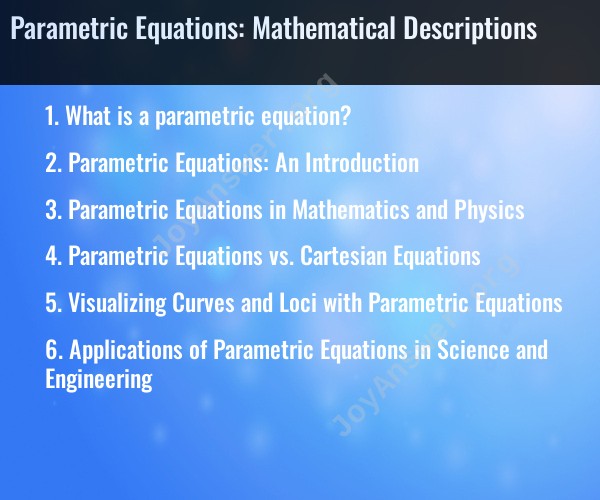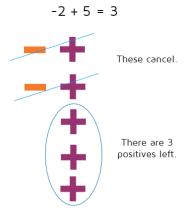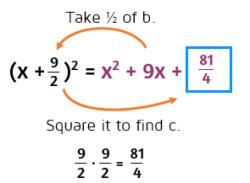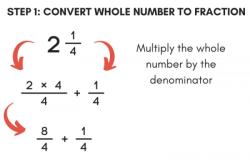What is a parametric equation?
A parametric equation is a mathematical representation of a curve or a set of points in a plane using one or more independent parameters, typically time. Instead of describing the curve in terms of a single variable like y = f(x), where both x and y are functions of a single parameter, a parametric equation defines each coordinate (e.g., x and y) as separate functions of one or more parameters (usually denoted as t or θ).
The general form of a parametric equation for a curve in the plane is often written as follows:
x = f(t)y = g(t)
Here, x and y are functions of the parameter t, and the functions f(t) and g(t) describe how the x and y coordinates change as the parameter t varies. The parameter t typically represents time, but it can represent any other independent variable or quantity depending on the specific problem or context.
Parametric equations are particularly useful for describing complex curves or motions where a single equation in the form of y = f(x) might not be sufficient. They allow for more flexibility in representing a wide range of shapes and behaviors, such as circles, ellipses, spirals, and even more intricate geometric patterns. They are commonly used in mathematics, physics, engineering, computer graphics, and other fields to model and analyze various phenomena.
Parametric Equations: An Introduction
Parametric equations are a way of representing curves and surfaces using one or more independent variables. This is in contrast to Cartesian equations, which represent curves and surfaces using only two independent variables, x and y.
Parametric equations are defined as follows:
x = f(t)
y = g(t)
where f(t) and g(t) are any functions of t. The variable t is called the parameter.
To graph a parametric curve, we simply evaluate f(t) and g(t) for different values of t and plot the resulting points.
Parametric Equations in Mathematics and Physics
Parametric equations are used in a wide variety of mathematical and physical applications. For example, they can be used to model the motion of a projectile, the path of a planet around the sun, or the shape of a wave.
Here are some examples of parametric equations in mathematics and physics:
- Motion of a projectile:
x = v_0 cos(θ)t
y = v_0 sin(θ)t - 1/2gt^2
where v_0 is the initial velocity of the projectile, θ is the angle at which the projectile is launched, and g is the acceleration due to gravity.
- Path of a planet around the sun:
x = a(cos(ωt + ε))
y = a(sin(ωt + ε))
where a is the semi-major axis of the planet's orbit, ω is the angular velocity of the planet, and ε is the eccentricity of the planet's orbit.
- Shape of a wave:
x = ct
y = A sin(kx - ωt)
where c is the speed of the wave, A is the amplitude of the wave, k is the wavenumber, and ω is the angular frequency.
Parametric Equations vs. Cartesian Equations
Both parametric equations and Cartesian equations can be used to represent curves and surfaces. However, there are some advantages and disadvantages to each approach.
One advantage of parametric equations is that they can be used to represent curves and surfaces that would be difficult or impossible to represent with Cartesian equations. For example, parametric equations can be used to represent curves with infinite length, such as the cycloid.
Another advantage of parametric equations is that they can be used to model the motion of objects. For example, the parametric equations for the motion of a projectile can be used to calculate the projectile's position at any time.
However, parametric equations also have some disadvantages. One disadvantage is that they can be more difficult to graph than Cartesian equations. Another disadvantage is that it can be difficult to eliminate the parameter from parametric equations in order to obtain a Cartesian equation.
Visualizing Curves and Loci with Parametric Equations
Parametric equations can be used to visualize curves and loci in a variety of ways. For example, we can use parametric equations to create animations of objects moving. We can also use parametric equations to generate plots of curves and surfaces using computer software.
Here are some examples of how parametric equations can be used to visualize curves and loci:
- Animation of a projectile: We can use the parametric equations for the motion of a projectile to create an animation of the projectile moving. This can help us to understand the projectile's motion and to predict its trajectory.
- Plot of a cycloid: We can use parametric equations to generate a plot of a cycloid. This is a curve that is traced by a point on the rim of a wheel as the wheel rolls along a straight line.
- Plot of a three-dimensional curve: We can use parametric equations to generate a plot of a three-dimensional curve. For example, we can use parametric equations to plot the shape of a spiral or a helix.
Applications of Parametric Equations in Science and Engineering
Parametric equations are used in a wide variety of scientific and engineering applications. For example, they can be used to model the motion of robots, to design aircraft and spacecraft, and to simulate fluid flow.
Here are some specific examples of how parametric equations are used in science and engineering:
- Modeling the motion of robots: Parametric equations can be used to model the motion of robots. This can help engineers to design robots that can move efficiently and accurately.
- Designing aircraft and spacecraft: Parametric equations can be used to design aircraft and spacecraft. This can help engineers to design vehicles that are aerodynamic and fuel-efficient.
- Simulating fluid flow: Parametric equations can be used to simulate fluid flow. This can help engineers to design bridges, dams, and other structures that are











